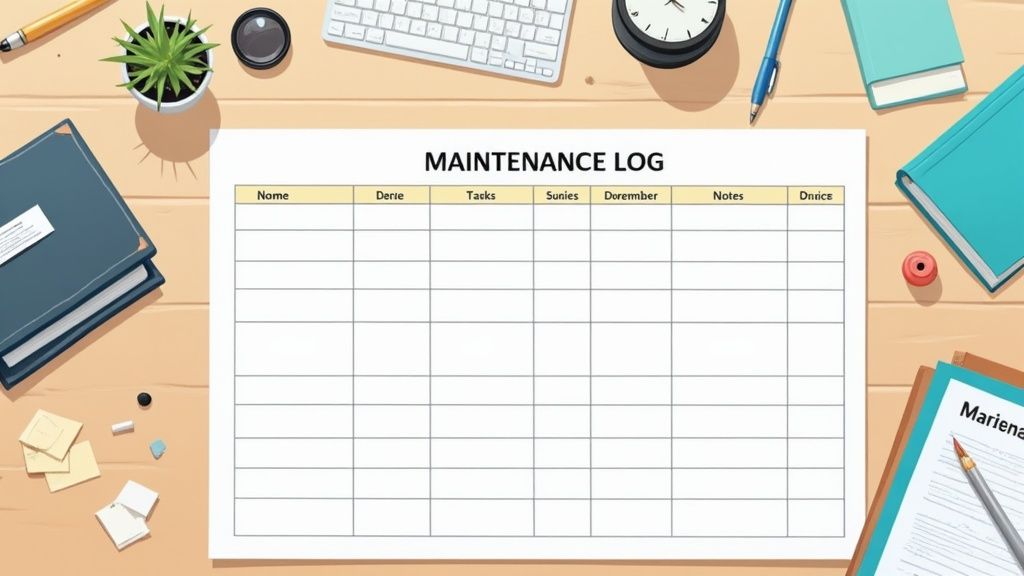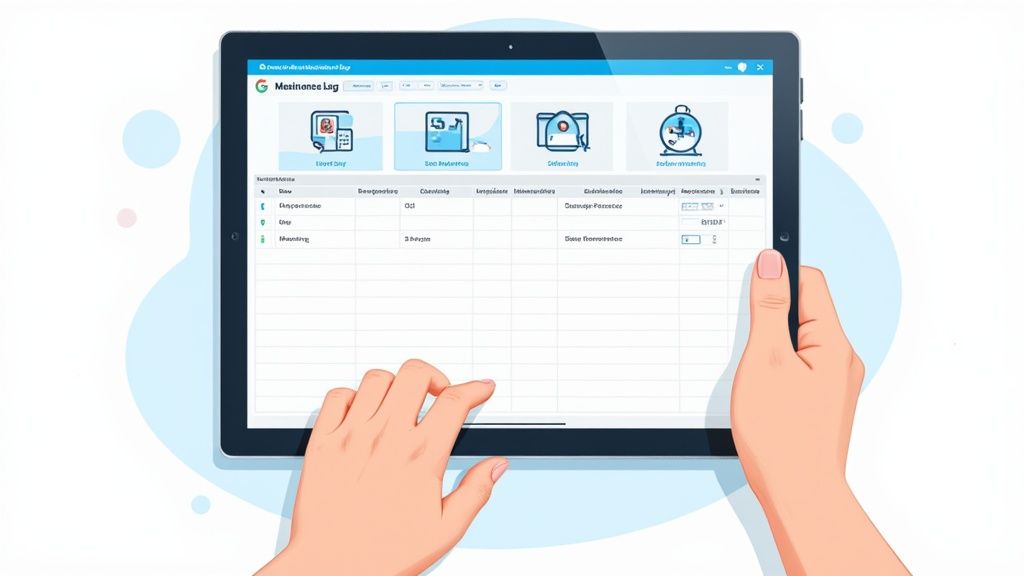
Get Your Free Vehicle Maintenance Log Template: The Ultimate Guide to Better Car Care
Why Every Vehicle Owner Needs a Maintenance Log

Your car or truck contains hundreds of parts working together in perfect harmony. When one component starts to fail, it can affect the entire system, leading to expensive repairs and breakdowns. A vehicle maintenance log helps you stay on top of service needs and track repairs systematically, ensuring no critical maintenance gets overlooked.
Regular upkeep does more than keep your vehicle running smoothly - it protects your investment. Cars and trucks that are well-maintained command higher resale prices since buyers value vehicles with documented service histories. Having detailed maintenance records gives potential purchasers confidence that the vehicle has been properly cared for.
Benefits of Using a Vehicle Maintenance Log
-
Prevent Costly Repairs: Catching small issues early through consistent monitoring helps avoid major mechanical failures. For example, following recommended oil change intervals protects your engine from damage that could cost thousands to repair.
-
Extend Vehicle Lifespan: Just as regular checkups help people stay healthy, following maintenance schedules keeps vehicles running longer. Addressing wear and tear promptly and sticking to manufacturer guidelines prevents premature aging of components.
-
Improve Fuel Efficiency: Taking care of your vehicle saves money at the pump. The US Department of Energy found that proper maintenance can boost fuel economy by up to 4.1%. By tracking service needs in a maintenance log, you can optimize performance and reduce fuel costs. Learn more at Simply Fleet.
-
Warranty Compliance: Most warranties require proof that you’ve followed the recommended maintenance schedule. A detailed log protects your coverage by documenting your adherence to manufacturer requirements.
-
Peace of Mind: When you know your vehicle is getting the care it needs, you can drive with confidence. Regular maintenance tracking eliminates the stress of wondering when critical services are due.
Making Informed Decisions
A maintenance log does more than track repairs - it helps you make smart choices about your vehicle’s future. The data reveals patterns in repair needs, helps forecast maintenance costs, and guides decisions about keeping versus replacing aging vehicles. This information empowers you to budget wisely and address issues before they become emergencies.
Essential Components of an Effective Maintenance Log Template

A good vehicle maintenance log does more than just track basic service information - it helps you manage costs and plan ahead for future maintenance needs. By including the right components, your log becomes an invaluable tool for keeping your vehicles running smoothly.
Core Information
The foundation of any maintenance log starts with these key details that give you a quick overview of each service:
- Date of Service: Noting when work was done helps track service intervals and spot maintenance patterns
- Vehicle Identification Number (VIN): Including the VIN ensures accuracy, especially when managing multiple vehicles
- Current Mileage: Recording mileage helps time preventive maintenance based on manufacturer guidelines
- Service Description: Clear descriptions like “Oil Change” or “Brake Pad Replacement” build a detailed service history
Detailed Service Information
Going beyond the basics, these specifics create a comprehensive record that’s valuable for analysis and budgeting:
- Parts Replaced: Document specific parts and part numbers used - this helps with warranty claims and tracking component issues
- Mechanic/Shop: Record where service was done to evaluate different providers’ quality and costs
- Cost: Track parts and labor expenses to monitor spending and calculate per-mile costs
- Notes: Add relevant details about problems found or mechanic recommendations to build vehicle history
A well-designed log template makes it easy to analyze spending patterns and determine ideal service timing. For instance, tracking costs helps calculate expenses per mile driven. You can find more tips for creating useful templates at Fleetio.
Advanced Tracking Options
Take your maintenance tracking further by monitoring these additional items:
- Fuel Economy: Regular fuel consumption tracking helps spot efficiency issues early
- Tire Pressure: Recording tire pressure readings promotes safety and better fuel economy
- Fluid Levels: Monitoring engine oil, coolant and brake fluid helps prevent damage
By including these essential components, your maintenance log becomes a practical tool for extending vehicle life, reducing repairs, and managing costs effectively.
Digital vs. Paper: Choosing Your Ideal Tracking Method

Keeping accurate records of your vehicle maintenance is essential for extending its lifespan and preserving its value. With several tracking methods available, finding the right approach for your needs can make a big difference in staying organized. Let’s look at the main options to help you choose what works best.
Paper Logs: The Traditional Approach
Many car owners start with a basic vehicle maintenance log book. These physical records provide a simple way to document service history without needing any special tools or technology. While paper logs are straightforward to use, they can get damaged or misplaced over time. Finding specific entries can also be time-consuming when flipping through pages of handwritten notes.
Spreadsheets: A Digital Upgrade
Digital spreadsheets offer better organization compared to paper records. You can easily enter data, calculate costs, and search for past maintenance details. For example, determining your total maintenance expenses or cost-per-mile becomes a quick calculation. Visit Vertex42 for free spreadsheet templates to track basic vehicle information, service history, and expenses. While spreadsheets work well for individual vehicles, they can become difficult to manage with multiple vehicles or extensive maintenance records.
Mobile Apps: The Modern Solution
Mobile apps like Auto Service Logger provide the most convenient way to track vehicle maintenance today. These apps include helpful features such as maintenance reminders, cloud backup of records, and detailed reporting capabilities. You can store digital copies of service documents and access your complete maintenance history anytime. This makes it easy to stay on schedule with required services and catch potential issues early.
Choosing the Right Fit
The best tracking method matches your personal workflow and maintenance needs. If you prefer keeping things simple, a paper log may work fine. For those who like working with computers, spreadsheets provide a good middle ground. However, for the most complete solution and convenience, a dedicated app like Auto Service Logger offers the best features for tracking vehicle maintenance over the long term. The lifetime access to your service records makes it a smart choice for any vehicle owner.
Customizing Your Template for Specific Vehicle Types

While a basic maintenance log works as a starting point, adapting it to your specific type of vehicle helps you track what matters most. By customizing your template, you can better follow manufacturer guidelines and focus on the components that need the most attention for your particular vehicle.
Tailoring Your Template to Vehicle Type
Each type of vehicle has unique service needs based on its design and use. For example, a commercial truck faces different demands than a family sedan due to its larger engine, heavier loads, and more frequent use. Here’s how to adapt your vehicle maintenance log template for different vehicle categories:
- Cars: Track basic services like oil changes, tire rotations, and brake checks. Include fuel economy monitoring to spot potential issues.
- Trucks: Add fields for suspension, drivetrain, and exhaust system inspections - components under higher stress. Record cargo weights to understand wear patterns.
- Motorcycles: Focus on chain care, tire conditions, and fluid levels. Document riding conditions since weather and road type affect maintenance needs.
Incorporating Manufacturer Schedules
Your vehicle’s owner’s manual lists recommended service intervals by mileage or time. Add these key maintenance points directly into your template to stay on track with required services. This helps protect your warranty coverage and prevents missing critical maintenance tasks.
Adjusting for Age and Usage
Maintenance needs change as vehicles age and depending on how they’re used. A newer vehicle may need only basic service, while older ones require more frequent checks of wear-prone parts. Consider your typical driving conditions too - if you regularly tow or drive off-road, plan for more frequent inspections of brakes, fluids, and other stressed components.
Example of a Customized Template
Here’s how a basic template can be modified for a delivery van:
| Item | Standard Template | Customized Template for Delivery Van |
|---|---|---|
| Mileage | Current Mileage | Current Mileage, Daily Mileage |
| Service | Oil Change | Oil Change, Brake Inspection (weekly), Tire Rotation (bi-weekly), Suspension Check (monthly) |
| Parts | Oil Filter | Oil Filter, Brake Pads, Tires |
| Notes | N/A | Load weight, Delivery route conditions |
A well-customized vehicle maintenance log template helps you provide better care for your specific vehicle. When you track the right details for your vehicle type, you can prevent problems before they occur and extend your vehicle’s life. For an easy way to manage your maintenance records digitally, check out Auto Service Logger.
Best Practices for Consistent Maintenance Tracking
Keeping detailed records of your vehicle maintenance log template helps protect your investment and catches problems before they become major issues. By developing good tracking habits early on, you can use the data to spot maintenance patterns, schedule timely service, and avoid unexpected repairs.
Integrating Tracking into Your Routine
Making maintenance logging part of your regular schedule is key to maintaining accurate records. Here are some proven ways to make it a habit:
- Set Automatic Alerts: Use Auto Service Logger to get mileage and time-based maintenance reminders
- Block Regular Time: Pick a specific time each week to update your logs, making it a natural part of your routine
Overcoming Common Challenges
Manual tracking can be time-consuming and prone to gaps. These tips help make the process smoother:
- Go Digital: Switch from paper logs to Auto Service Logger to save time and keep records secure
- Keep It Simple: Design your vehicle maintenance log template to be quick and easy to fill out
- Share the Work: For fleets, assign tracking duties to multiple team members to prevent burnout
Ensuring Data Reliability
Good data helps you make smart maintenance decisions. Follow these practices to keep your records accurate:
- Check Records Monthly: Review logs regularly to catch and fix any errors
- Use Standard Terms: Create clear categories and labels everyone follows
- Choose Secure Storage: Keep records protected yet accessible with Auto Service Logger
Practical Delegation and Data Management
When multiple people service your vehicles, clear communication keeps records consistent:
- Document Procedures: Write out what needs to be logged and who handles each task
- Keep Everything Central: Use Auto Service Logger’s platform to give the right access to mechanics and staff
Following these practices helps maintain complete service records that support smart vehicle management. Tools like Auto Service Logger make it simpler to track maintenance thoroughly and reliably over time.
Using Your Maintenance Log Data for Better Decision Making
A detailed vehicle maintenance log template helps you make smarter choices about your vehicles based on real data, not just guesswork. Whether you manage a single car or an entire fleet, analyzing maintenance records reveals important patterns about vehicle health, repair costs, and performance. Let’s explore how you can use this data to save money and keep vehicles running smoothly.
Predictive Maintenance and Problem Prevention
Looking at maintenance records over time helps spot potential issues before they become major problems. For example, if you notice brake pads wearing out faster than normal, it may signal alignment problems or aggressive driving habits that need attention. Fleet managers report that catching problems early through data analysis can reduce unexpected repair costs by up to 25%. This proactive approach keeps vehicles on the road longer.
Optimizing Service Intervals
Regular review of maintenance data helps determine the best timing for different services. Without good records, you might change oil too frequently and waste money, or wait too long and risk engine damage. Real-world data shows how your specific vehicles perform under actual driving conditions. This allows you to adjust service timing for maximum efficiency while maintaining reliability.
Repair or Replace Decisions
When facing major repairs on older vehicles, maintenance logs provide vital context for smart decisions. By adding up recent repair costs, checking fuel efficiency trends, and factoring in depreciation, you can determine whether fixing or replacing makes more financial sense. The data often reveals when repair expenses start exceeding the value of keeping an aging vehicle running.
| Decision Factor | Repair Consideration | Replace Consideration |
|---|---|---|
| Frequency of Repairs | Low frequency, predictable | High frequency, unpredictable |
| Maintenance Costs | Manageable and declining | Escalating and unpredictable |
| Vehicle Performance | Maintaining expected levels | Subpar or diminishing |
Calculating True Ownership Costs
Use your maintenance history to figure out the real cost per mile, including repairs, routine maintenance, and fuel usage. This complete picture helps with budgeting and planning. Tools like Auto Service Logger make it easy to track and analyze these costs over time.
Good maintenance records give you the data needed to make informed choices about your vehicles. Consider using digital tools like Auto Service Logger to track everything systematically. With reliable data guiding your decisions, you can maximize vehicle life while minimizing unexpected costs and downtime.